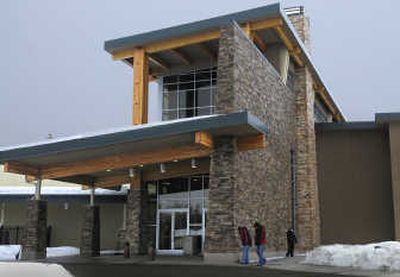Camas Center offers services for Kalispel tribe

USK, Wash. – Kalispel tribal elder Stan Bluff seems an unlikely health statistic. Fit and calm and wearing a cowboy hat, he acknowledges that he suffers from heart disease and diabetes — medical conditions that afflict his people and other American Indians in numbers so great that it has spurred calls to eat right and get fit.
The Kalispel tribe’s 393 members answered, building the $18 million Camas Center for Community Wellness on the tiny reservation along the Pend Oreille River in northeast Washington.
The building is a soaring 7,700-square-foot gem in this rural outpost, situated near the tribe’s impressive buffalo herd and powwow grounds. The Camas Center was funded by profits from the tribe’s Northern Quest Casino outside of Spokane. About a third of the tribe lives in Spokane.
There’s a 25-meter lap pool and two activity pools for children. There are weight benches and treadmills, stationary bicycles and other machines designed to boost heart rates. A small café serves healthy foods. There’s a climbing wall and gymnasium able to seat 300 people, plus a day care and preschool, meeting rooms and offices.
Perhaps most importantly, the center is home to a medical and dental clinic that will offer lab services, x-rays, dieticians, physical therapists and chiropractic care to tribal members and other members of the community. The cost for a family membership is about $50 a month. Dental and medical care is charged separately.
During opening ceremonies for the wellness center last week, Bluff talked about how the Kalispel people had historically lived healthy lives.
“They lived with nature and everything that the Creator provided,” he said, gesturing to the river valley that would blossom purple with Camas more than a century ago, yielding nutritious bulbs that were a dietary staple.
But lifestyle changes, fatty foods and inactivity have taken a toll. “To me, this is a godsend,” Bluff said, recalling that a wellness center was among the first things the tribe wanted to build when its gaming enterprise began to produce a profit.
“This is for the children,” he said, “they are the ones who will benefit.”
The disparity in health between American Indians and other Americans is startling. Infant mortality rates are more than double those of whites; diabetes is 2.6 times more likely; suicide rates are twice the national average; and life expectancy is about six years less.
These are numbers that other tribes have been trying to combat for years.
The Coeur d’Alene tribe was among the first in the region to build a wellness center. Theirs is in Plummer, Idaho.
It was finished a decade ago and remains an important service for the tribe, with more than 2,000 members who use the gym, said Quanah Spencer, the tribe’s spokesman.
He said the focus on preventative health is serving the tribe’s goal of returning to a healthy heritage.
Like the Camas Center, the Coeur d’Alene Tribe’s wellness facility also is open to non-tribal members.
The opening of the Camas Center comes amid what is expected to be a renewed push in the U.S. Senate this week to reauthorize funding for the federal Indian Health Services program. President Bush has threatened a veto, pointing to labor provisions in the reauthorization bill that would require workers in those facilities and on new projects to be paid locally prevailing wages. Such changes in the bill would violate longstanding administration policy.
U.S. Sen. Patty Murray is a co-sponsor of the federal bill, which would authorize $35 billion over the next decade. The money would be used to build clinics and sanitation facilities; establish programs addressing domestic violence and sexual abuse; offer cancer screenings beyond mammograms; and enroll more American Indians in Medicare, Medicaid and the State Children’s Health Insurance Program, said Matt McAlvanah, a Murray spokesman.
The bill would also provide funding for urban clinics that the president didn’t include in his budget proposal.
Tribal members often use Urban Indian Health Program clinics rather than traveling to Indian Health Service clinics on reservations, which can be impractical and costly.
Joe Pakootas, executive director of Camas Path, which will manage the wellness center, said Kalispel tribal members have had to travel to Wellpinit on the Spokane Indian Reservation if they wanted care from an Indian Health Services clinic. That’s a 71-mile drive from Usk.
Instead, they’ve often traveled to Spokane for care at an urban Indian clinic, he said.
While the wellness center won’t replace that service, the medical and dental clinic should make basic health care more readily available in Usk and could be funded by Medicare and Medicaid dollars if the bill passes. For Alec Bluff, the grandson of Stan Bluff, the wellness center provides a great place to sharpen his basketball skills and meet friends.
“I’m really going to like this place,” the 11-year-old said.